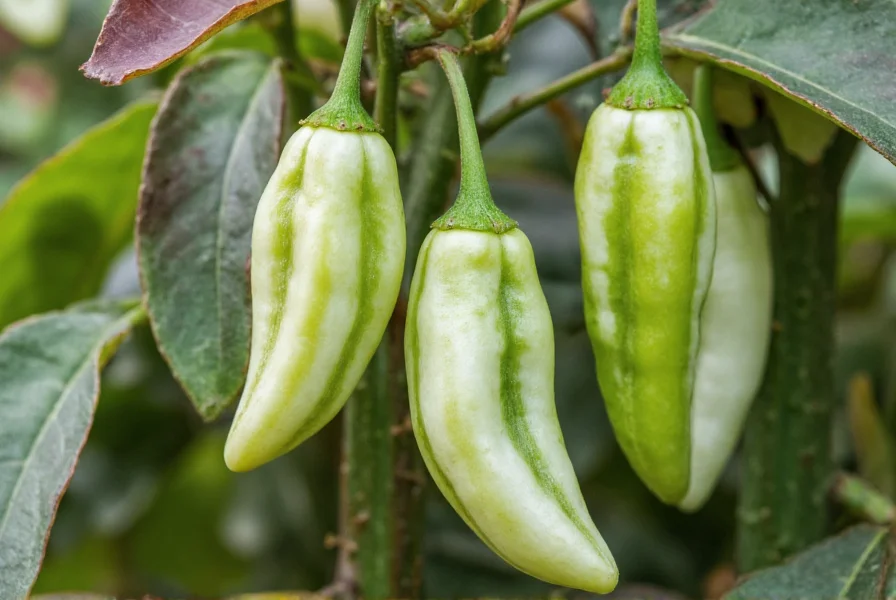Fish pepper represents one of America's most fascinating culinary heirlooms, with a story that intertwines African American history, regional cuisine, and agricultural preservation. This unique chili variety features distinctive variegated foliage and peppers that begin as striking white and green stripes before maturing to vibrant red. Its moderate heat level makes it versatile for numerous culinary applications while maintaining the delicate balance required for seafood dishes.
Historical Significance of Fish Pepper
Originating in the Caribbean, fish pepper made its way to the United States through the transatlantic slave trade. By the 19th century, it became a staple in Chesapeake Bay region cooking, particularly among African American communities. Historical records show that enslaved gardeners at Bartram's Garden in Philadelphia cultivated this variety as early as the 1800s.
The pepper earned its name because chefs discovered its subtle heat and citrus notes enhanced seafood dishes without overpowering the delicate flavors. Fishermen and oyster harvesters in the Chesapeake region commonly used it in crab cakes, oyster stews, and fish sauces. For decades, it remained a regional secret until nearly disappearing from cultivation in the mid-20th century.
Thanks to seed saver William Woys Weaver's research in the 1980s, fish pepper was rediscovered and reintroduced to modern gardeners and chefs. This preservation effort represents one of the most successful heirloom chili revivals in American culinary history.

Physical Characteristics and Flavor Profile
Fish peppers typically measure 2-4 inches in length with a conical shape similar to serrano peppers. The most distinctive feature is their variegated coloring—starting as creamy white with green stripes, then transitioning through yellow and orange before reaching full red maturity. This visual transformation makes them particularly attractive in gardens.
On the Scoville scale, fish peppers register between 5,000-8,000 units, placing them in the moderate heat category—comparable to serrano peppers but generally milder. What sets them apart is their complex flavor profile featuring:
- Initial citrus notes (lemon and lime)
- Subtle floral undertones
- Clean heat that builds gradually
- Earthy finish without bitterness
| Characteristic | Fish Pepper | Serrano Pepper | Jalapeño Pepper |
|---|---|---|---|
| Scoville Units | 5,000-8,000 | 10,000-23,000 | 2,500-8,000 |
| Flavor Profile | Citrusy, floral | Grassy, bright | Grassy, vegetal |
| Best For | Seafood, sauces | Salsas, guacamole | General cooking |
| Maturation Time | 70-80 days | 70-80 days | 70-80 days |
Culinary Applications of Fish Pepper
While historically associated with seafood, fish pepper's versatility extends to numerous culinary applications. Chefs appreciate how its moderate heat enhances rather than dominates dishes. When selecting fish peppers for cooking, consider these applications:
Seafood Preparation
The traditional use remains its strongest application. Finely minced fish pepper adds subtle heat to:
- Crab cakes and seafood salads
- Seafood sauces and remoulades
- Grilled fish marinades
- Oyster po'boys and fish tacos
Unlike hotter peppers that can overwhelm delicate seafood flavors, fish pepper provides just enough warmth to enhance without masking the natural taste of the fish.
Other Culinary Uses
Creative chefs have expanded fish pepper's applications to include:
- Vinegar infusions for salad dressings
- Compound butters for grilled meats
- Pickled peppers for charcuterie boards
- Sauces for poultry and pork dishes
- Hot sauces with distinctive citrus notes
When substituting fish pepper in recipes calling for other chilies, use a 1:1 ratio for jalapeños but reduce quantity by 25% when replacing serranos due to its slightly milder heat profile.

Growing Fish Peppers
Gardeners increasingly seek fish pepper plants for their ornamental value and culinary utility. The plants grow to approximately 2-3 feet tall with variegated leaves that provide visual interest throughout the growing season.
For successful cultivation:
- Start seeds indoors 8-10 weeks before last frost
- Transplant outdoors when soil reaches 70°F
- Provide full sun (6-8 hours daily)
- Maintain consistent moisture without waterlogging
- Harvest when peppers show full striping (for milder flavor) or when fully red (for maximum heat)
Fish peppers thrive in containers, making them suitable for balcony or patio gardening. The plants typically produce fruit continuously from mid-summer through first frost. For gardeners in cooler climates, growing fish peppers in containers allows moving plants indoors when temperatures drop.
Fish Pepper Substitutes
When fish pepper isn't available, several alternatives can approximate its flavor profile:
- Serrano peppers with lemon zest: Provides similar heat with added citrus notes
- Jalapeño with a touch of habanero: Creates moderate heat with subtle fruitiness
- Shishito peppers with citrus: For milder applications requiring visual appeal
- Tabasco peppers: Similar heat level with vinegar compatibility
For authentic Chesapeake Bay seafood dishes, the closest approximation combines jalapeño peppers with a small amount of lemon or lime zest to mimic fish pepper's distinctive citrus notes.
Where to Find Fish Pepper
While still considered a specialty item, fish pepper has become more accessible through:
- Specialty seed companies (Seed Savers Exchange, Baker Creek Heirloom Seeds)
- Farmers markets in the Mid-Atlantic region
- Online hot sauce retailers featuring heirloom varieties
- Some gourmet grocery stores during peak growing season
Gardeners can preserve the harvest by drying, pickling, or freezing fish peppers. Dried fish peppers maintain their distinctive flavor and can be reconstituted for sauces or ground into seasoning blends.
Frequently Asked Questions
What makes fish pepper different from other chili varieties?
Fish pepper's distinctive feature is its variegated white and green striped appearance when young, maturing to red. It offers a unique citrusy flavor profile with moderate heat (5,000-8,000 Scoville units) that complements seafood without overwhelming it, unlike many hotter chili varieties.
Can I grow fish peppers in containers?
Yes, fish peppers grow well in containers. They typically reach 2-3 feet in height, making them suitable for pots of 5 gallons or larger. Container growing allows gardeners to move plants indoors when temperatures drop, extending the harvest season in cooler climates.
What's the best substitute for fish pepper in recipes?
The closest substitute combines jalapeño peppers with lemon or lime zest to mimic fish pepper's citrus notes. For recipes requiring visual appeal, shishito peppers with added citrus can work well. When replacing fish pepper in seafood dishes, use 25% less serrano pepper to account for the higher heat level.
Why is it called fish pepper?
It earned the name because Chesapeake Bay region chefs discovered its subtle heat and citrus notes enhanced seafood dishes without overpowering the delicate flavors. Fishermen and oyster harvesters commonly used it in crab cakes, oyster stews, and fish sauces throughout the 19th century.
How hot are fish peppers compared to jalapeños?
Fish peppers range from 5,000-8,000 Scoville units, placing them in the same heat range as jalapeños (2,500-8,000 units) but generally at the higher end of that spectrum. However, fish peppers have a cleaner heat with citrus notes that makes them seem milder in culinary applications than their Scoville rating might suggest.











 浙公网安备
33010002000092号
浙公网安备
33010002000092号 浙B2-20120091-4
浙B2-20120091-4